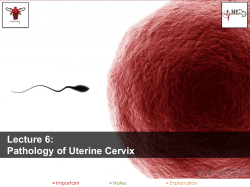
CERVICAL SCREENING What your abnormal result means
area where HPV testing has started, your sample will be checked to see whether you have cleared the HPV infection. If HPV is found, you will be referred for another colposcopy. If you don’t have HPV, you will be screened again in three years. If HPV testing hasn’t yet started where you live, then you will have two tests, one six months after treatment and another twelve months after. If both these follow-up tests are normal, then you may be advised to have annual screening for a while. If either of your follow-up tests shows abnormalities, you will be referred for colposcopy. The screening programme will write to advise you of the follow-up that you need. What about sex? Sex does not make any abnormality worse, and you cannot pass on abnormal cells to your partner. Enjoy sex as usual, but you should use an effective contraceptive. It is important not to get pregnant until your abnormality is dealt with, as the hormones produced during pregnancy make treatment more difficult. Colposcopy will have no effect on your future fertility. The colposcopist will discuss with you the possible effect that treatment may have if you become pregnant in the future. Pregnant women needing treatment may be advised to wait until after the birth of their baby. Further information Cancer Screening Programmes If you have any questions regarding your condition or if you feel worried at all, do not hesitate to phone or make an appointment with your GP, who will be happy to talk to you. Summary • About one in 20 women have an abnormal cervical screening result, so it is not particularly unusual. Published by the Department of Health in association with NHS Cancer Screening Programmes and Cancer Research UK CERVICAL SCREENING • Nearly all abnormal tests show no more than small changes in the cells on the cervix. These changes would probably never develop into cancer, but it is sensible to monitor them. • Treatment, if needed, is simple and virtually 100 per cent effective. You will usually be treated as an outpatient. The colposcopist will discuss any effects treatment may have on pregnancy. • You can have sex again within a few weeks of treatment. • Having an abnormal screening result does not affect your ability to have children. © Crown copyright 2012 Produced by Williams Lea for the Department of Health 2900168 8p 40k Jan14 (TRS) The text of this document may be reproduced without formal permission or charge for personal or inhouse use. If you require further copies of this title visit www.orderline.dh.gov.uk and quote 2900168 Tel: 0300 123 1002 Fax: 01623 724524 Minicom: 0300 123 1003 (8am to 6pm, Monday to Friday) 2900168 can also be made available on request in Braille, audio and large print. www.cancerscreening.nhs.uk What your abnormal result means You have had an abnormal result from your cervical screening test. Cervical screening is designed to pick up minor changes before any problems develop, and almost certainly that is what the test has done for you. An abnormal result is not unusual: about one in 20 women have test results that show some abnormality. It is important to remember that it is extremely rare for an abnormality found at screening to be cancer. Nearly all abnormal results show no more than small changes in cells. These act as an early warning sign that, over time, cervical cancer may develop. What does my result mean? An abnormal result usually means that small changes have been found in the cells on the cervix (the neck of the womb). The name given to these changes is dyskaryosis. In many cases these changes return to normal by themselves. But sometimes the changes become worse and could lead to cancer in the future. In such cases it is necessary to have a further examination which will show if treatment is needed. Treatment is simple and virtually 100 per cent effective. Fortunately, it usually takes many years for cancer of the cervix to develop. So it is very rare, especially in women who have regular cervical screening, for an abnormal result to show that cancer has already developed. What causes an abnormal result? Changes in the cells of the cervix are often associated with the human papilloma virus (HPV), which is transmitted by sexual intercourse. There are over 100 types of this virus, and certain types are linked with nearly all cases of cervical cancer. Most women are infected with HPV at some point in their lives, but most infections disappear without the need for treatment. Even women with ‘high risk’ HPVs rarely go on to develop cervical cancer. HPV often shows no symptoms. It is therefore possible that you may have had the virus for many years without knowing about it, or a partner may have been infected many years ago and, again, not know. for a colposcopy. If no high-risk HPV is found, then you don’t need any further tests, and you will simply be called again for screening in three or five years’ time (depending on your age). If HPV testing hasn’t yet started where you live and you have borderline changes or mild (lowgrade) dyskaryosis, then your GP will usually ask you to return for a repeat screening test in about six months’ time. This allows the cell changes time to return to normal by themselves. If the repeat test is normal, then you will be asked to have two more tests at six-monthly intervals, to be sure that the cells are still healthy. If they are, you will go back to being screened every three or five years. If the repeat test still shows borderline changes or mild (low-grade) dyskaryosis, then you will be invited to go for a colposcopy. Borderline changes or mild (low-grade) dyskaryosis. Moderate or severe (high-grade) dyskaryosis. For many women their abnormal result will show borderline changes or mild (low-grade) dyskaryosis. The areas of changed cells are known as cervical intraepithelial neoplasia, or CIN. CIN is graded on a scale of 1 to 3. Mild (low-grade) dyskaryosis is associated with the grade CIN 1. These changes are not cancer, and in most cases do not lead to cancer in the future. We are starting to introduce HPV testing of cervical screening samples that show borderline changes or mild (low-grade) dyskaryosis. If you live in an area where HPV testing has been introduced and high-risk HPV is found in your screening sample, then you will be invited to go For some women their abnormal result will show moderate or severe (high-grade) dyskaryosis. These areas of changed cells are associated with the grades CIN 2 and CIN 3. Even with CIN 2 or CIN 3 grade changes, it is unlikely that you have cancer. However, these changes are less likely to return to normal by themselves, and usually need treatment. To decide whether you need treatment, a colposcopy examination will be carried out to investigate the cervix in detail. It is important that these changes are checked now, in case they become more serious in the future. What is colposcopy? This is a simple examination at a colposcopy clinic which allows the doctor to decide if you need treatment. An instrument called a colposcope is used. This is a type of microscope or magnifying glass which lets the doctor look more closely at the changes on your cervix. It does not touch you or go inside you. The examination is very similar to the screening test, so women may find it a bit uncomfortable. If you need colposcopy, make sure you receive the leaflet ‘Cervical Screening: The colposcopy examination’. What about treatment? If you need treatment following colposcopy you will usually be treated as an outpatient and there will be no need for you to stay in hospital. Treatment is nearly always 100 per cent successful. The area of changed cells will be removed from the cervix. The method for this will vary from clinic to clinic, but it is a simple procedure and will be carried out under local anaesthetic. What follow-up will I need? If you do need treatment, you will be asked to have a follow-up screening test six months afterwards to check that all the abnormal cells have gone. If this test shows that you have moderate or severe (high-grade) dyskaryosis, you will be referred for another colposcopy. If the test is normal or shows borderline changes or mild (low-grade) dyskaryosis, and you live in an
© Copyright 2025













